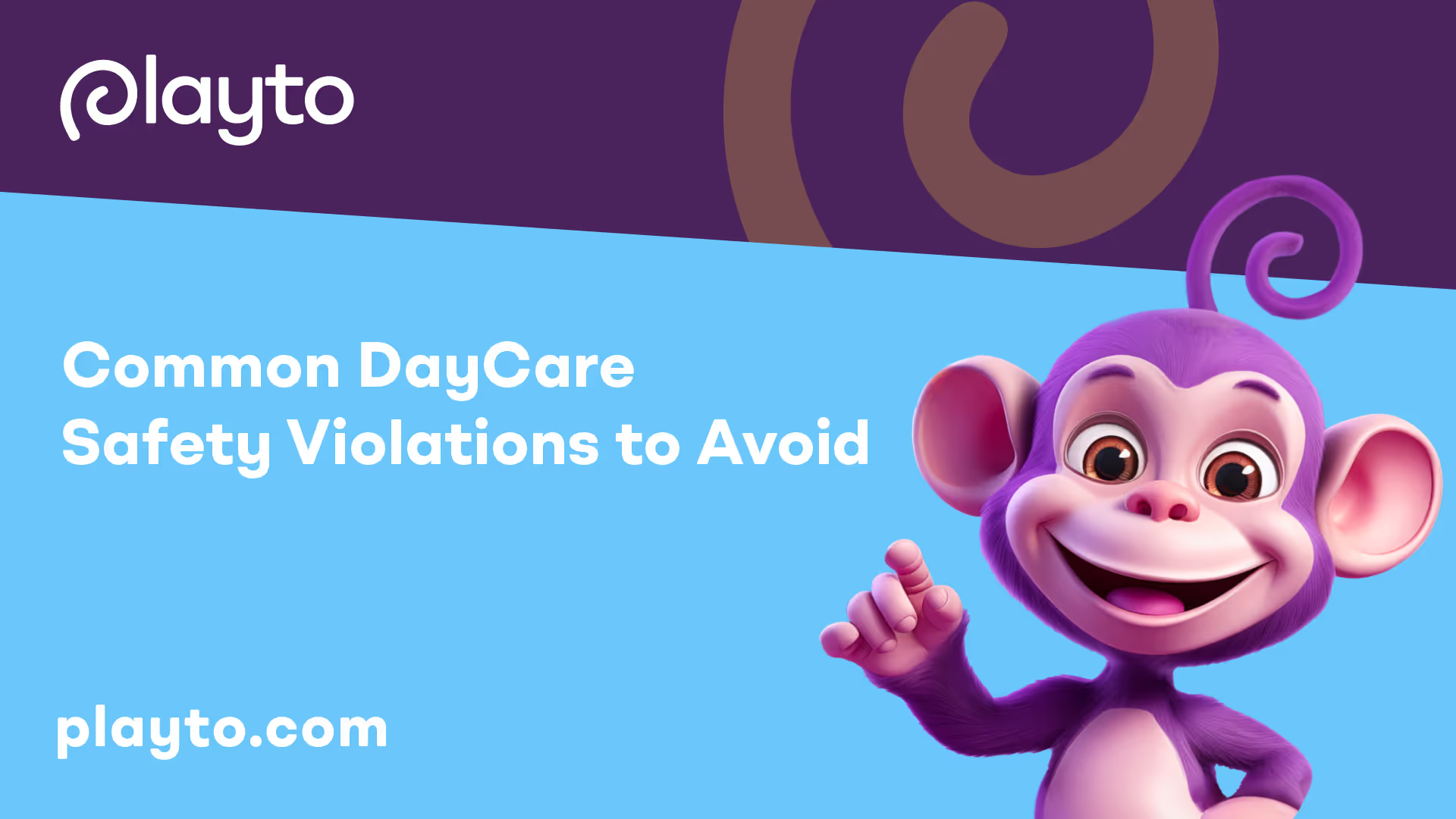
Common Daycare Safety Violations
Understanding common daycare safety violations is crucial for maintaining a safe and secure environment for children. These violations can be categorized into health and safety risks, operational risks, compliance risks, financial risks, and reputational risks.
Health and Safety Risks
Health and safety risks in daycare centers encompass a wide range of potential hazards. These risks can arise from slips, trips, and falls, as well as life-threatening allergies and bullying. Ensuring a safe physical environment and monitoring children's interactions are essential to mitigate these dangers.
Table: Common Health and Safety Risks
Risk Type Description
- Slips, Trips, and Falls: Physical injuries due to wet floors or obstacles.
- Allergies: Life-threatening reactions to food or environmental factors.
- Bullying: Emotional or physical harm from other children.
For more on health and safety measures in daycare, visit health and safety in daycare facilities.
Operational Risks
Operational risks in daycare settings can disrupt daily activities and affect the overall management of the facility. These risks include staff shortages, breakdowns in meal programs, manual data entry errors affecting billing and attendance tracking, and external events such as power outages due to storms.
Risk Type Description
- Staff Shortages: Insufficient staff to meet child care ratios.
- Meal Program Breakdowns: Issues with food preparation and serving schedules.
- Manual Data Entry Errors: Mistakes in billing and attendance tracking.
- External Events: Power outages or natural disasters affecting operations.
Compliance Risks
Daycare centers must adhere to numerous local, state, and federal laws to maintain their license. Compliance risks can include failing to maintain proper staff-to-child ratios, hiring unqualified employees, and not following zoning and fire codes as outlined by Brightwheel.
Compliance Area Description
- Staff Ratios: Maintaining mandated staff-to-child ratios.
- Hiring Practices: Ensuring employees meet qualification and background check requirements.
- Zoning and Fire Codes: Adhering to local building and fire safety regulations.
For more on compliance and safety protocols, visit what to look for in daycare safety protocols.
Financial Risks
Financial risks in daycare centers can impact their ability to meet financial obligations. Issues such as cash flow problems, insurance liability, employee misconduct, and financial mismanagement are highlighted risks. According to Brightwheel, these financial issues can jeopardize the sustainability of the daycare.
Financial Risk Description
- Cash Flow Issues: Inability to manage incoming and outgoing finances smoothly.
- Insurance Liability: Costs arising from insurance claims and liabilities.
- Employee Misconduct: Financial consequences of staff wrongdoings.
- Financial Mismanagement: Inefficient management of funds and resources.
Reputational Risks
Reputational risks involve potential harm to the daycare center’s public image. These risks can arise from negative incidents that garner public attention, such as violations of health and safety standards or involvement in legal issues.
Reputational Risk Description
- Publicized Incidents: Negative events that draw media or public scrutiny.
- Health and Safety Violations: Breaches that make parents distrust or leave the daycare.
- Legal Issues: Lawsuits or legal complications affecting public perception.
For further information on preparing for and managing these risks, visit understanding daycare security measures.
By addressing these common daycare safety violations, centers can create a safer, more reliable environment for children, staff, and families.
Most Common Violations in Daycare Centers
Addressing safety and compliance in daycare centers is pivotal for creating a secure environment for children. Here are some of the most common violations that can jeopardize daycare safety and how to avoid them.
Staff Behavior Deficiencies
Inconsistencies in staff behavior can lead to serious safety risks. Falling short of standards for treating children, including negative attitudes and physical abuse, is a significant infraction. According to Famly, this was the most common deficiency in Texas childcare centers. Ensuring regular staff training and safety protocols are followed can mitigate these risks.
Issue Example
- Negative Attitudes: Dismissing children's needs.
- Physical Abuse: Mishandling or rough behavior.
Background Check Protocol
Adhering to strict background check protocols for early childhood education (ECE) staff is non-negotiable. Violations occur when new hires start before their background check results are received. Daycare centers must ensure all staff have completed their background checks prior to employment to avoid compliance risks.
For more information, see our article on background checks and screening.
Fire Safety Certification
Maintaining up-to-date fire safety certification is crucial. A common violation involves not keeping proper fire safety documentation or experiencing delays in annual fire safety inspections. Regular reviews and timely scheduling with local fire marshals can help maintain compliance.
Certification Requirement
- Fire Safety: Annual inspection and certification.
- Evacuation Plans: Updated and practiced regularly.
For further details, check our page on daycare fire safety and evacuation plans.
Building and Equipment Maintenance
Proper maintenance of the daycare facility is essential. Violations can include poor sanitization, pest control issues, and malfunctioning HVAC systems [1]. Ensuring regular inspections and maintenance of the building and playgrounds can prevent these issues.
Maintenance Issue Example
- Sanitization: Dirty restrooms, unclean surfaces.
- Pest Control: Infestations, inadequate pest deterrents.
- HVAC Systems: Faulty heating or cooling.
For additional insights, explore our article on playground safety at daycare.
Documentation of Child Health Records
Properly maintaining children's health and immunization records is a legal requirement. Many violations are due to the failure to keep up-to-date records, which can expose children to health risks [1]. Implementing a diligent record-keeping system helps stay compliant and ensures child safety.
Record Type Importance
- Health Records: Monitoring child health and illnesses.
- Immunization Records: Proof of required vaccinations.
For more on this, read our article on how daycare manages child illness.
By identifying and rectifying these common violations, daycare centers can provide a safer environment for children and maintain compliance with legal standards. This article is crucial for anyone interested in understanding daycare safety protocols.
Ensuring Child Care Safety
Ensuring child care safety in daycare centers is vital to providing a secure and nurturing environment for children. Below, we explore key areas that daycare providers should focus on to avoid common safety violations.
Food Safety Measures
Food safety in daycare centers is essential for preventing foodborne illnesses and ensuring the well-being of children. Child care safety tips emphasize the need for cleanliness, proactive contamination prevention, proper cooking methods, and food storage practices. Adhering to these protocols can significantly minimize health risks associated with improper food handling.
Essential food safety measures include:
- Regular hand washing before handling food
- Thorough cleaning and sanitizing of kitchen surfaces and utensils
- Properly cooking and storing food at safe temperatures
- Identifying and preventing cross-contamination
- Implementing strict policies for handling food allergies and intolerances (food allergy safety in daycare)
Background Checks and Screening
Conducting comprehensive background checks and criminal screenings for all individuals with access to children in daycare centers is crucial for ensuring child safety. This helps to prevent individuals with potentially harmful backgrounds from having contact with children.
To ensure thorough background checks:
- Perform criminal background checks at both state and federal levels
- Verify references and previous employment in child care settings
- Regularly update screenings to include staff, volunteers, and contractors
- Utilize a Child Care Management System to track employee certifications (daycare staff training and safety)
Gatekeeper Implementation
A gatekeeper system enhances security by ensuring only authorized individuals gain access to the daycare center. This safety measure prevents unauthorized entry and helps safeguard the children.
Key features of a gatekeeper system include:
- Restricted access points with secure entry mechanisms
- Check-in and check-out procedures for staff and visitors
- Visitor logs and identification verification
- Regular audits and updates to access control systems (understanding daycare security measures)
Staff Training Requirements
Proper staff training is fundamental to child care safety. Staff members should be well-versed in safety protocols, first aid, and emergency response techniques. Compliance with training requirements ensures that employees are prepared to handle any situation effectively [2].
Important training areas include:
- CPR and First Aid certifications
- Safe sleep practices for infants (safe sleep practices in daycare)
- Fire safety and evacuation procedures (daycare fire safety and evacuation plans)
- Recognizing and responding to child illness (how daycare manages child illness)
Training Requirement Certification Frequency
Preparedness for High-Risk Situations
Preparation for high-risk situations is a critical aspect of child care safety. Daycare centers must have clear procedures and protocols to handle emergencies and unexpected events [2].
Preparedness strategies include:
- Developing comprehensive emergency response plans
- Conducting regular drills for various scenarios (e.g., fire, evacuation, lockdown)
- Ensuring all staff are familiar with the emergency plans
- Maintaining easily accessible emergency contact information for all children
For more information on what to look for in daycare safety protocols and other safety-related topics, visit our articles on health and safety in daycare facilities and what to look for in daycare safety protocols.
Cleaning and Health Standards
Effective cleaning and health standards are crucial for preventing common daycare safety violations and ensuring a safe environment for children. Below, we explore key aspects of maintaining cleanliness in daycare centers.
Importance of Disinfection
Disinfection in daycare settings is vital for maintaining a healthful environment for children. The Centers for Disease Control and Prevention (CDC) emphasize the importance of using appropriate disinfectants on surfaces and objects that children frequently touch. Daycare facilities should follow a more frequent cleaning schedule compared to other environments to mitigate the spread of pathogens [3].
Cross-Contamination Risks
Daycare centers, bustling with activity and high traffic, present numerous opportunities for the rapid spread of germs and cross-contamination. Shared toys, eating utensils, play areas, and restroom facilities all contribute to this heightened risk. Specialized cleaning protocols are necessary to address these challenges effectively.
Risk Area Examples
- Shared Items: Toys, books, eating utensils.
- Common Areas: Play areas, restrooms.
- High-Touch Points: Doorknobs, light switches, faucet handles.
Industry Cleaning Standards
The International Sanitary Supply Association (ISSA) has established industry standards for daycare cleaning, which provide a framework for best practices. These standards cover protocols for cleaning high-touch areas, recommendations for cleaning tools, and criteria for assessing cleanliness. Adherence to these standards is essential for maintaining high levels of cleanliness and safety in daycare centers.
Federal and State Guidelines
Federal and state guidelines offer extensive recommendations for cleaning and sanitizing daycare facilities. Compliance with these guidelines is crucial for ensuring a safe and healthy environment for children. For instance, non-adherence to California state guidelines can result in penalties, including the revocation of a facility's license.
Guideline Source Key Recommendations
- Federal: Regular cleaning schedules, approved disinfectants.
- State: Adherence to specific cleaning protocols, inspection.
Cleaning High-Touch Surfaces
High-touch surfaces in daycare settings, such as doorknobs, light switches, faucets, tables, chairs, and toys, are critical points for thorough cleaning and disinfection due to their frequent contact. The CDC recommends cleaning and disinfecting these surfaces at least once daily. Experts often suggest multiple cleanings throughout the day, particularly during flu seasons or pandemics.
Ensuring the cleanliness of these areas can significantly reduce the risk of common daycare safety violations. For more information on health and safety in daycare, check out our guide on what to look for in daycare safety protocols and the importance of health and safety in daycare facilities.
High-Touch Surface Recommended Cleaning Frequency
These comprehensive cleaning and health standards help daycare centers not only meet regulatory requirements but also ensure the safety and well-being of children. For additional information on related safety topics, explore our articles on safe sleep practices in daycare and playground safety at daycare.
